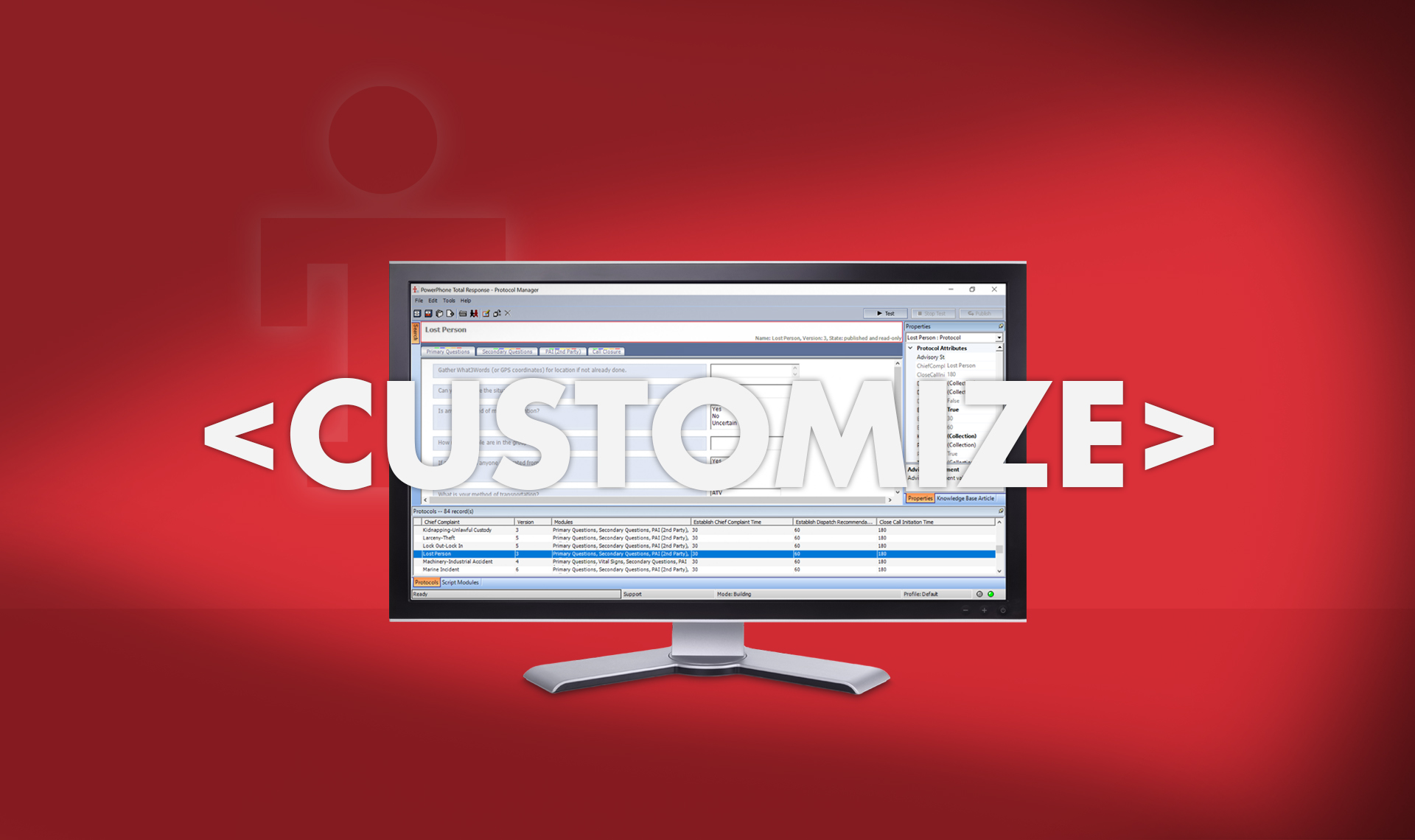Our customers—from site administrators to call takers, from small centers, to large PSAPs employing dozens of dispatchers—tell us all the time that they wish it was easier and less costly to get protocols modified to meet their agencies’ and communities’ needs. PowerPhone now makes it easier than ever to customize the protocols of its Total Response software.
With Total Response, we help craft your protocols to meet your own custom needs. In fact, with the Script Builder module, we give you the ability to tweak your protocols on your own, so you can easily modify what dispatchers see on the screen to meet the exact needs of your own organization and the communities you serve and protect.
With all types of responders relying on the information dispatchers gather using Total Response, it’s essential to incorporate these stakeholders into the customization process at your organization. Total Response is designed to collect information based on the type of call, not the response type. Including input from each type of responder creates buy-in and critical collaboration across departmental lines.
My own experience comes from years of serving as a paramedic, firefighter, and then working as a 911 dispatcher. I joined PowerPhone first as a trainer, and now I’m an implementation manager—helping agencies get off to a running start.
Customizing Protocols to Meet Specific Needs
My work with PowerPhone has taken me into 911 communication centers around the country, where I’ve seen how wonderfully unique each community is, and the different ways in which they work to keep their citizens safe. Total Response is continuously updated to meet evolving needs, which is why most agencies simply use it out of the box. But we take pride in the ease and efficiency in which organizations can tweak protocols to match their local situations and needs.
Working with a sheriff in Iowa, I was asked to insert a question for our motor vehicle fire protocol. He wanted to add a question about the type of fuel source the vehicle had. The batteries in hybrid and electric vehicles burn extremely hot and need massive amounts of water. He said it could take up to 30,000 gallons of water to extinguish a battery fire, and they would need to activate a tanker shuttle to provide water if hydrants weren’t present. I was able to insert the question on the spot, and we’ve since made it part of our default protocol.
Cross Departmental Collaboration
Did you know that there are nearly 18,000 police agencies in the United States and each one can have its own 911 operating procedures that they want reflected in Total Response? Police need as much information as possible within the constraints of a call: Condition of victim, description of suspect, scene assessment, the presence of weapons or other hazards.
PowerPhone pioneered crafting protocols for law enforcement. In fact, we created the very first Police and Fire protocols and pre-arrival instructions. A DOT/NHTSA initiative created EMS protocols, but emergency call handling protocols for Police and Fire dispatch simply did not exist until PowerPhone developed them.
With thousands of different police and sheriff’s departments, we know that PSAPs will want to adjust protocols to better match their standards of procedures. In those cases, the police chief, sheriff, lieutenant, or whomever oversees the project, can sit down and review the protocols, making changes when needed. Often, it is as easy as re-ordering questions, and Total Response makes it easy to re-order, add new, or remove questions.
Total Response provides a robust set of protocols that can be customized to meet the exact guidance of local medical directors, ranging from which medical conditions are inquired about, to the exact ordering of how they want their questions asked. Other stakeholders can also implement customizations. For instance, PSAPs serving rural areas may want to incorporate questions early to determine whether emergency air transport is required.
Fire departments value the easy customization of protocols to address diverse concerns in different locations. For instance, a rural PSAP requested questions about wind direction and adjacent property types for the grass fire protocol to assess the risk of flames spreading, including questions about structures and potential fuel sources like propane tanks. Another agency added a car fire question asking whether the car was on a road bordering a farm, to help prevent flames spreading to crops and causing a wildfire.
PowerPhone Protocol and Procedure Review Committee: We’re Always Listening
PowerPhone Implementation Managers, working with agencies in the field, as well as everyone else on our team that has customer contact, are always listening to what dispatchers and site administrators have to say. We bring these questions and feedback to regular meetings of our PowerPhone Protocol and Procedure Review Committee (PPRC). So, in addition to helping agencies create their own customizations, we also look for ideas that should be added to our protocols for all customers to benefit. This committee also ensures that our protocols are meeting all industry standards. Some changes wait for the next release, while others (such as asking about hybrid and EVs in car fires) are so important that we immediately push them out to the field.
Customizing? We Want to Help
While some agencies make customizations before deployment, we find that others craft customizations after using Total Response for a while. Often the suggestions come from dispatchers using Total Response every day and then suggest ideas to a site administrator on changes they would like to see to more efficiently handle the situations they face.
Organizations can make protocol changes on their own, but we want to be included in the process—which is why customers can consult with us anytime. We can help ensure that any customization doesn’t impact the logical flow of how answers direct the dispatcher to the next appropriate question, a suggested dispatch recommendation, or direction to applicable Pre-Arrival Instructions. Additionally, we might see universal value to your customization and adopt it for our default system so all current and future Total Response customers can benefit from it in this vitally important work of 911 professionals.

About the Author
Joe Lefebvre is an Implementation Manager with over 26 years in public safety. Joe is a retired MA firefighter/paramedic and served as an Uxbridge PD Telecommunicator/Supervisor for 15 years. Prior to his role as an IM, he was a PowerPhone Instructor for 10 years.









